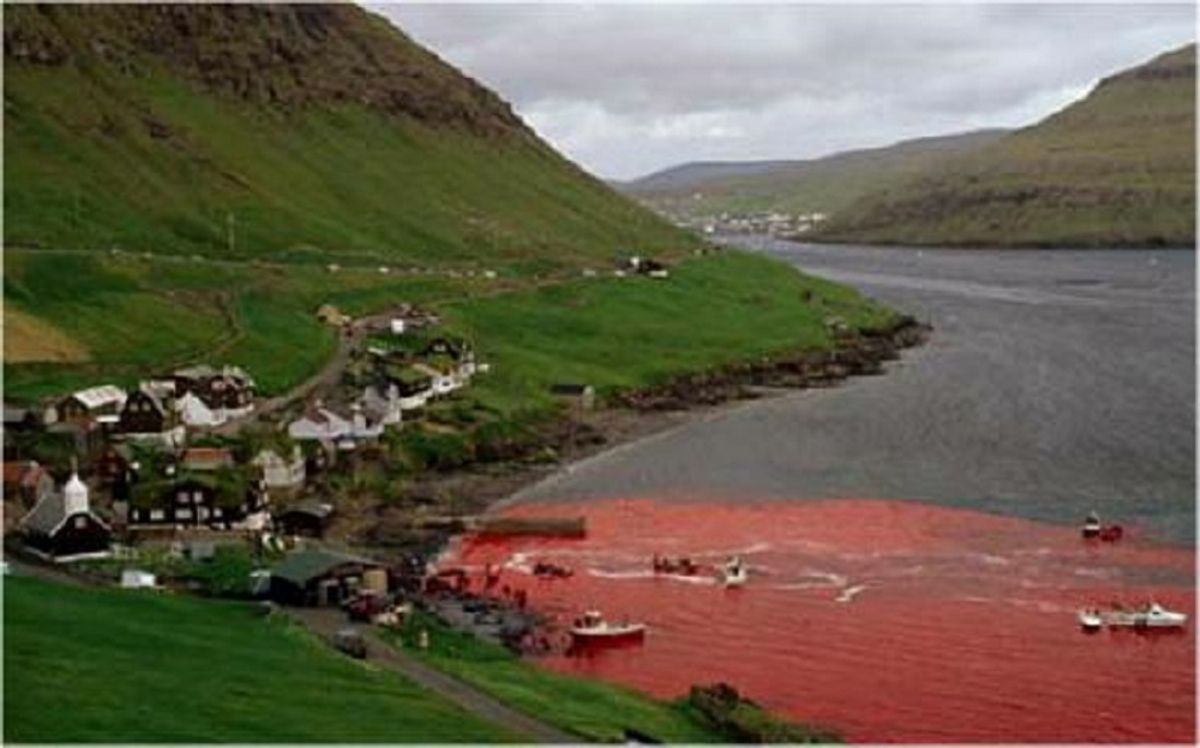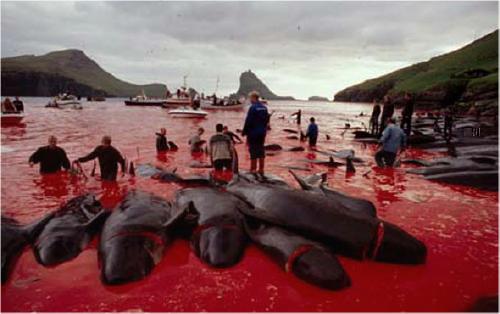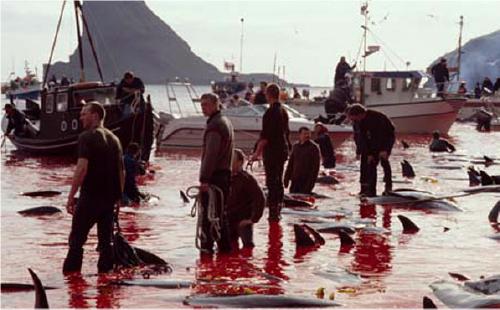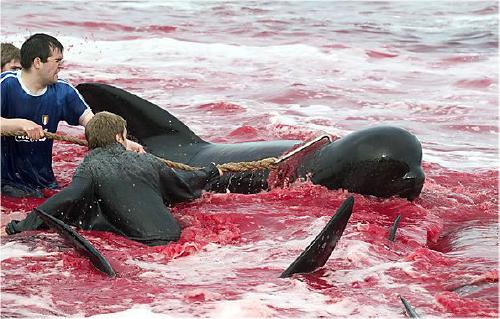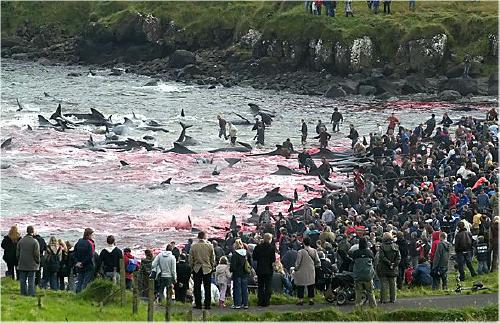Denmark is a big shame
The sea is stained in red and in the mean while it's not because of the climate effects of nature.
It's because of the cruelty that the human beings (civilised human) kill hundreds of the famous and intelligent Calderon dolphins.
This happens every year in Feroe iland in Denmark. In this slaughter the main participants are young teens.
WHY?
To show that they are adults and mature.... BULLLLsh
In this big celebration, nothing is missing for the fun. Everyone is participating in one way or the other, killing or looking at the cruelty "supporting like a spectator"
Is it necessary to mention that the dolphin calderon, like all the other species of dolphins, it's near instinction and they get near men to play and interact. In a way of PURE friendship
They don't die instantly; they are cut 1, 2 or 3 times with thick hocks. And at that time the dolphins produce a grim extremely compatible with the cry of a new born child.
But he suffers and there's no compassion till this sweet being slowly dies in its own blood
Its enough!
We will send this mail until this email arrives in any association defending the animals, we won't only read. That would make us accomplices, viewers.
Take care of the world, it is your home!
The photographs displayed above were taken in 2005 and document a drive hunt (commonly known as a "grind") of long-finned pilot whales by residents of the Faroe Islands (which are an autonomous province of Denmark), an activity that has long been a subject of international controversy.
The whale hunt has been a part of the Faroe Island culture for hundreds of years, but in recent decades the practice has increasingly become the subject of international protest and condemnation. Supporters of the hunt maintain that the killing of pilot whales is "an age-old communal, noncommercial hunt aimed at meeting the community's need for whale meat and blubber," that the animals are dealt with so quickly that their pain is brief, and that whale meat accounts for a quarter of the Faroe islanders' annual meat consumption.
Conservationists charge that the hunts, which may take hundreds of whales at a time, are barbaric and pointless, that "the practice is outdated, cruel and unnecessary for a place with one of the highest standards of living in Europe," and that most of the whales go to waste (either being left on the beach to rot or thrown back to sea after they are killed.
According to Russell Fielding, a geographer from the University of the South in Sewanee, Tennessee:
The Faroese are opportunistic hunters who launch a grind only when specific conditions are met. The animals must be close to shore, near one of 23 beaches approved as a landing beach. The weather and currents have to be calm enough. And there have to be enough participants to crew the dozen or so powerboats required to drive the animals toward shore.
In some years, such as in 2008, conditions weren't right and no whales were taken. But over the past three centuries, the Faroese have taken an average of 838 pilot whales and 75 dolphins each year, Fielding reported in a 2012 study.
The Faroese usually target long-finned pilot whales, says Fielding, although they will also take bottlenose dolphins, white-sided dolphins, and Risso's dolphins. Risso's dolphins are sometimes landed even though they aren't on the Faroe government's list of species approved for hunting.
None of the species are considered endangered, although the International Union for Conservation of Nature lists long-finned pilot whales as "data deficient," meaning there isn't enough scientific evidence to judge the status of the North Atlantic population.
A Faroe Islands whaling site page describes such hunts unfolding as follows:
Whale drives only take place when a school of pilot whales is sighted close to land, which is most often from a local fishing boat or ferry, and when sea and weather conditions make it possible. This can take place at any time of the year, but catches are most common in July and August when the days are long and the weather is more stable. Notice of the school is sent to the elected whaling officials and to the district administrator (sýslumaður) responsible for the whale drive, and is spread as widely and quickly as possible in the local community so that enough people and boats can join in the drive. Employers usually make allowances for members of their staff to take time off during whale drives.
The boats gather in a wide semicircle behind the whales and slowly and quietly begin to drive them
towards the chosen authorised bay. On the whaling foreman’s signal, loose stones and stones attached to lines are thrown into the water behind the whales, helping to herd the whales towards the beach where they become stranded. According to the regulations, any group of whales which cannot be beached in this manner must be driven out to sea again.A crucial factor in ensuring an effective whale drive is the organisation of participants, both in boats and on shore, in addition to prevailing weather and tidal conditions during driving and beaching. The spontaneous nature of a whale drive requires swift mobilisation of manpower to drive and kill a group of large wild animals quickly. Whale drives are only initiated when whales are sighted by chance close to land.
Faroese animal welfare legislation, which also applies to whaling, requires that animals are killed as quickly and with as little suffering as possible. Whales are killed on the shore and in the shallows of bays especially authorised for the purpose. A regulation spinal lance must be used to sever the spinal cord, which also severs the major blood supply to the brain, ensuring both loss of consciousness and death within seconds. This, in addition to the supplementary use of the traditional whaling knife, if necessary, is the most efficient and humane means of killing beached pilot whales safely, with many participants involved at the same time.
In recent years, two new items of equipment have been developed and formally approved and required as standard equipment. The blow-hole hook used to secure the whales causes no injury prior to slaughter and is now widely used. The spinal lance has now also been introduced as the preferred standard equipment for killing pilot whales. It has been shown to reduce killing time to 1-2 seconds while also improving accuracy and safety (see also under Whaling and animal welfare). The Faroes participate actively in the work of the NAMMCO Committee on Hunting Methods, where veterinary experts and experienced hunters from different countries share information and work to develop best practices for the humane killing of marine mammals.
In 1986 the International Whaling Commission (IWC) introduced "zero catch limits for commercial whaling"; however, the IWC's rules still allow for subsistence hunting in some parts of the world, and the application of their regulations to long-finned pilot whales is somewhat ambiguous since (despite their name) those animals are not whales proper; they are (like dolphins) small cetaceans, and they belong to the same biological family (Delphinidae) as dolphins.
In late 2008, chief medical officers of the Faroe Islands advised that they no longer considered pilot whales to be fit for human consumption because the animals' meat and blubber had been found to contain too much mercury, PCBs and DDT derivatives.
As noted above, the Faroe Islands are an autonomous province of Denmark and not a part of Denmark itself; essentially a self-governing country within the Kingdom of Denmark, with their own prime minister and legislature.
